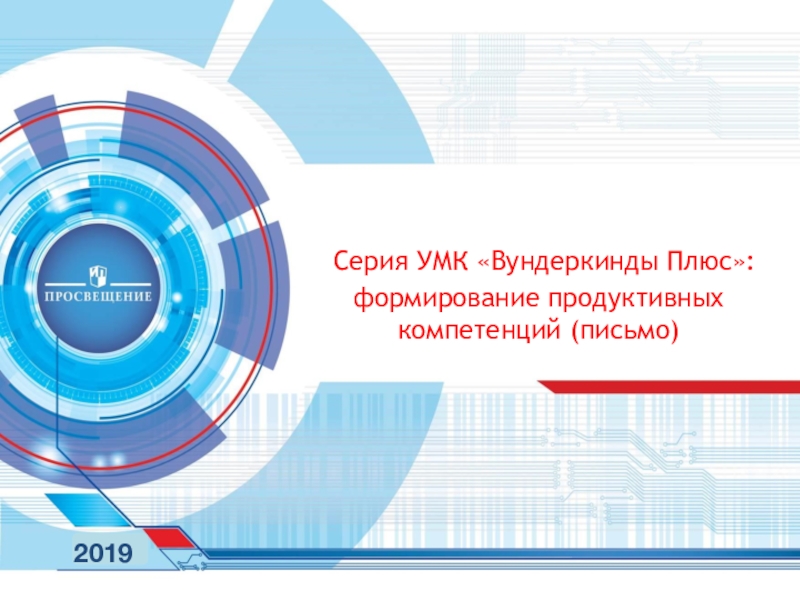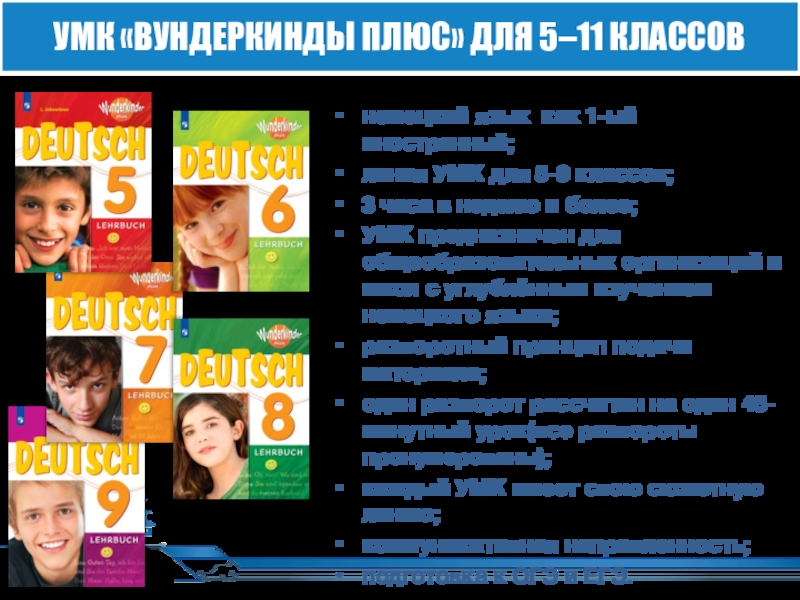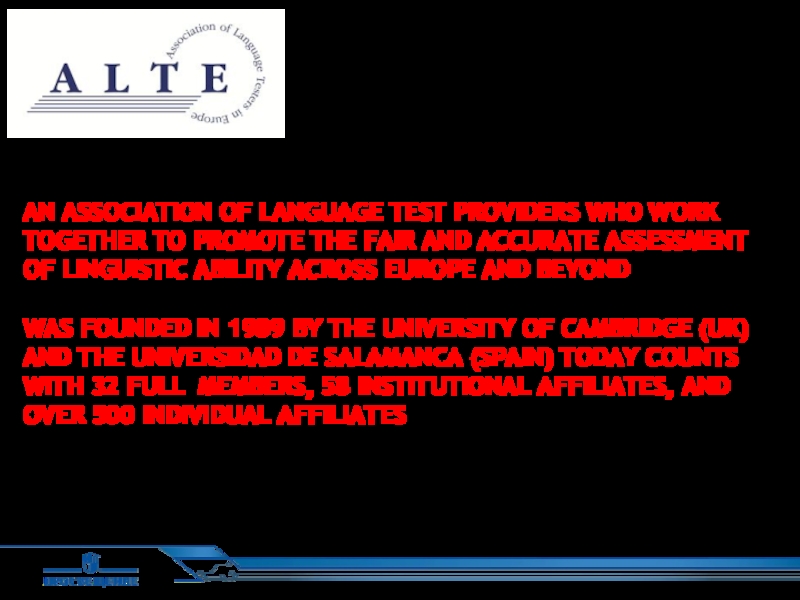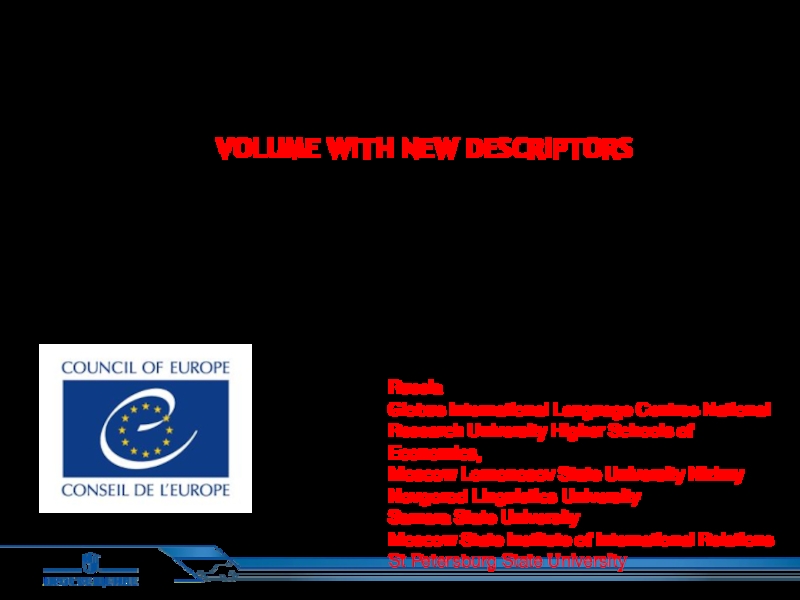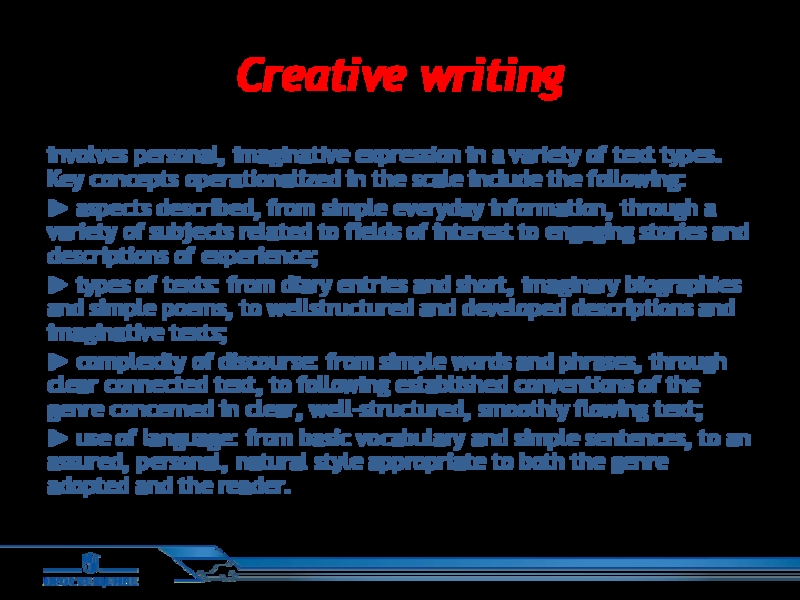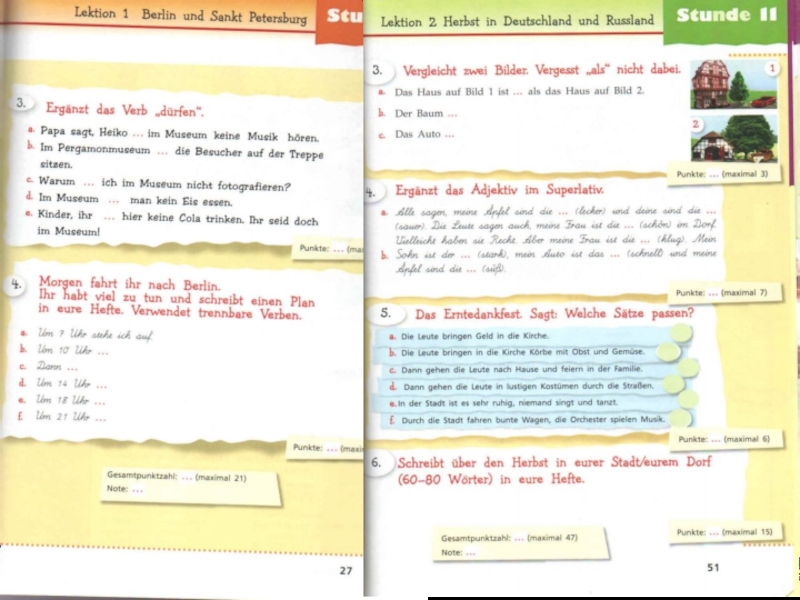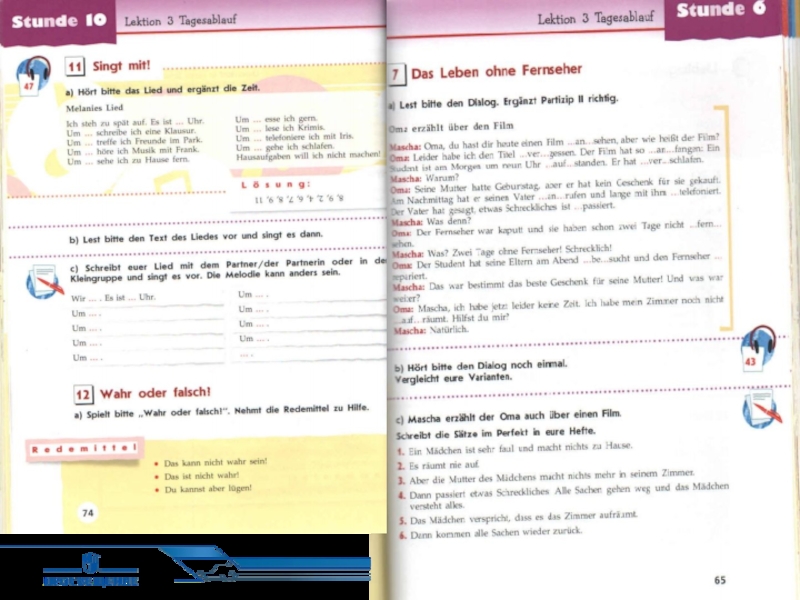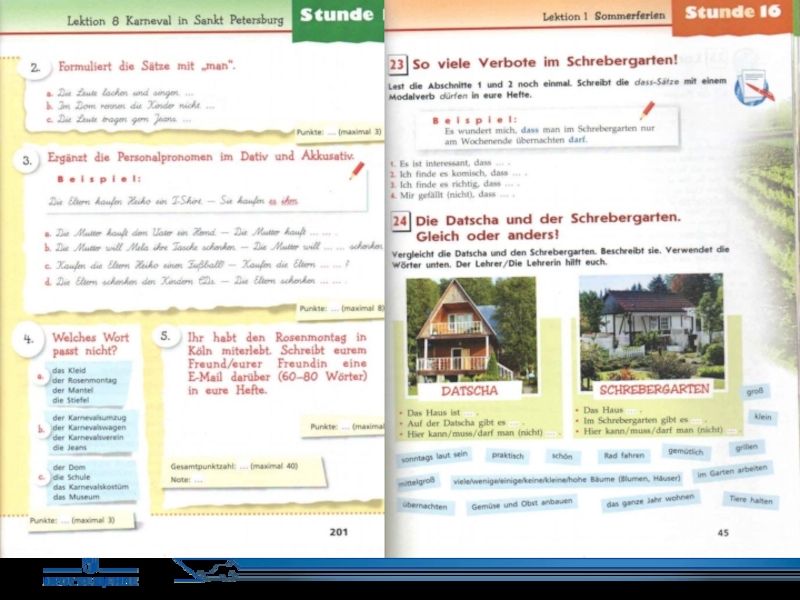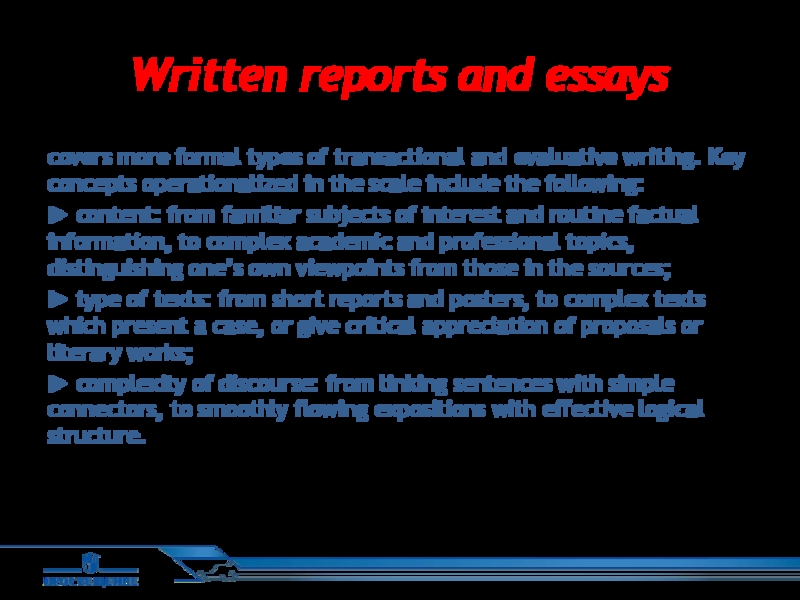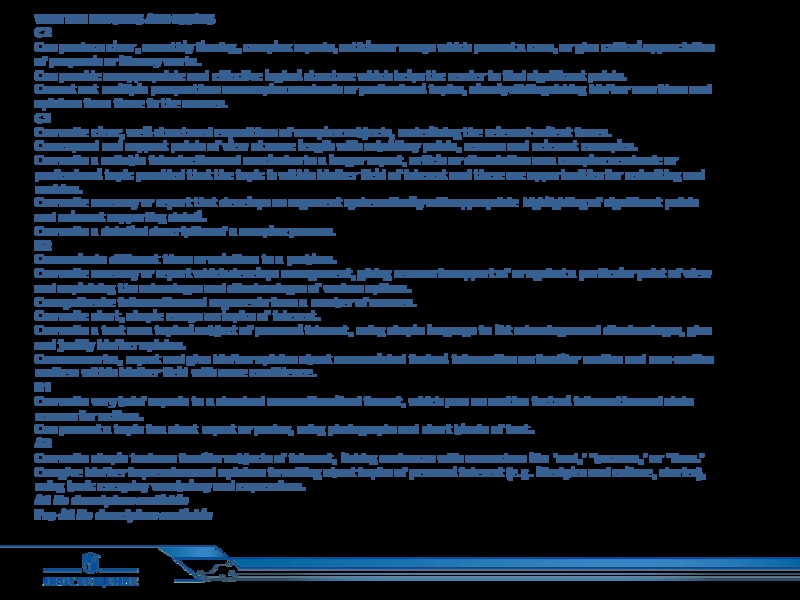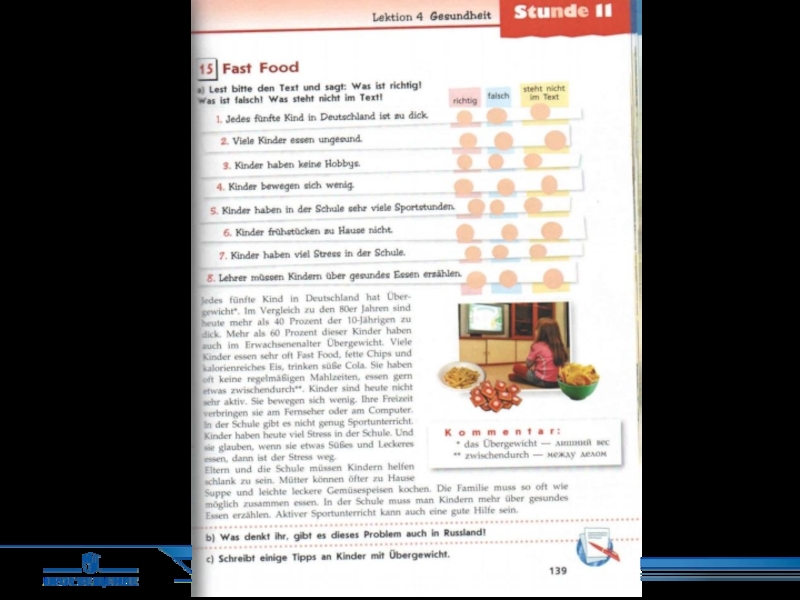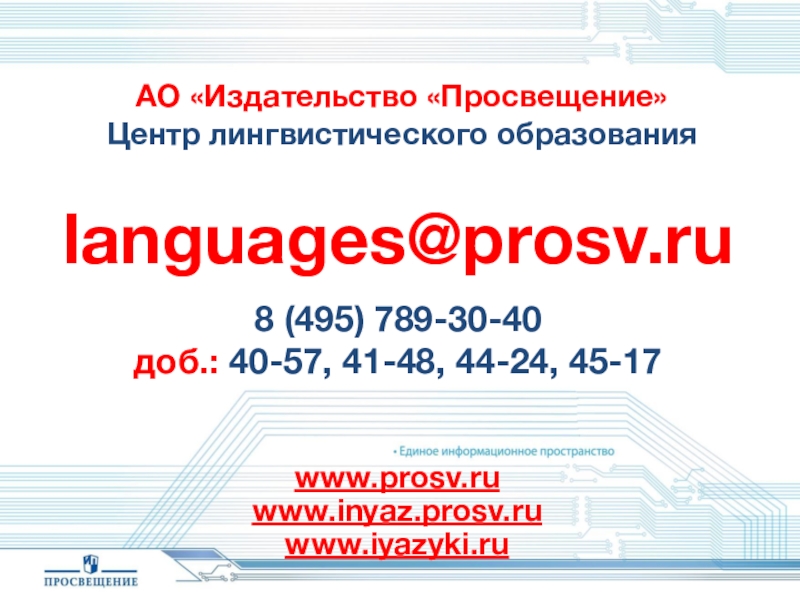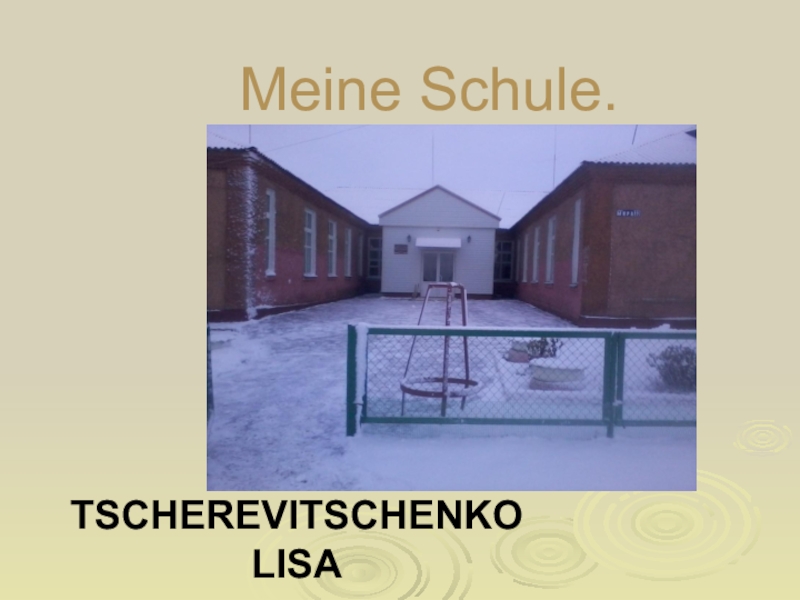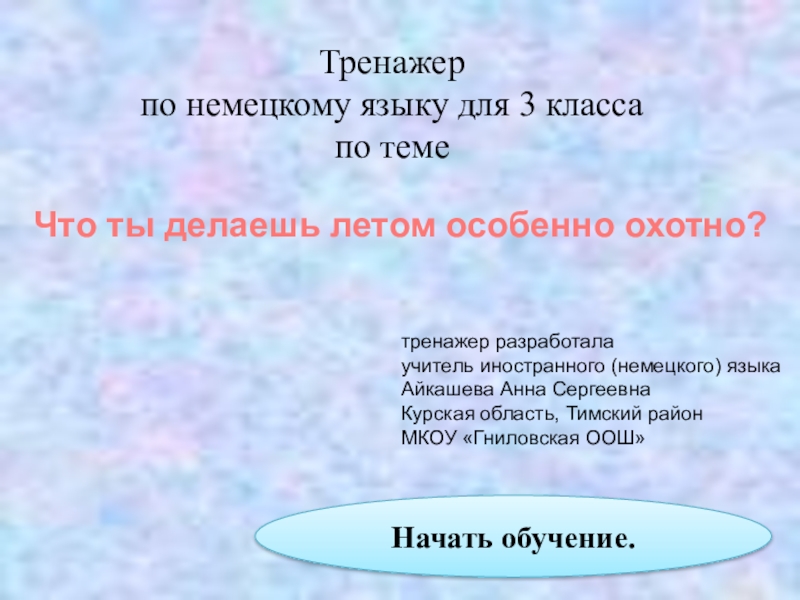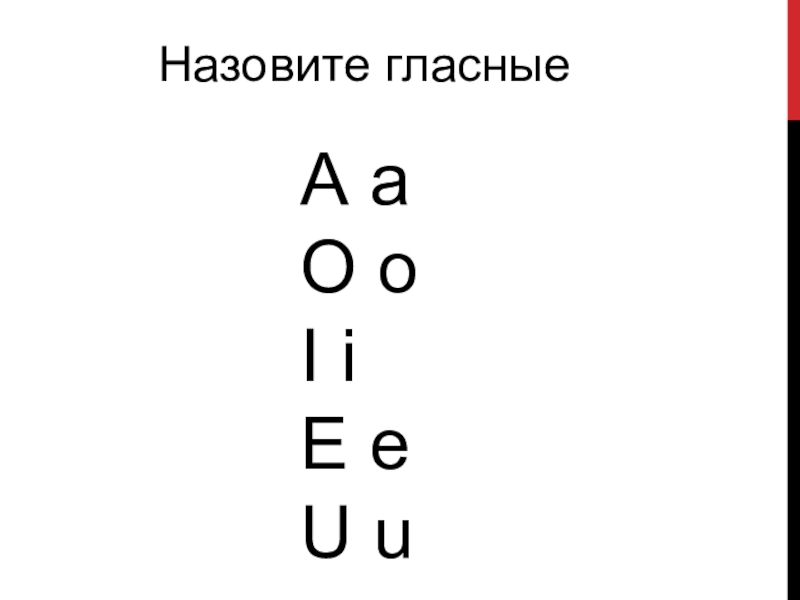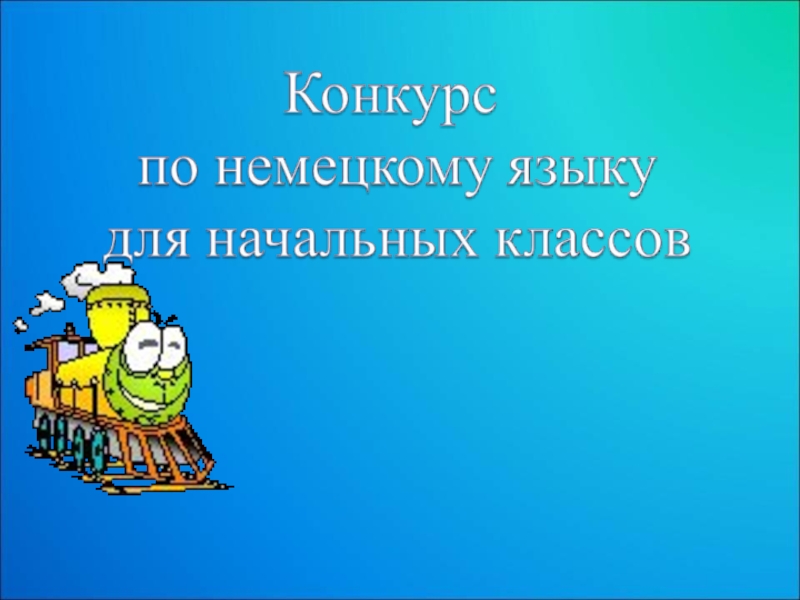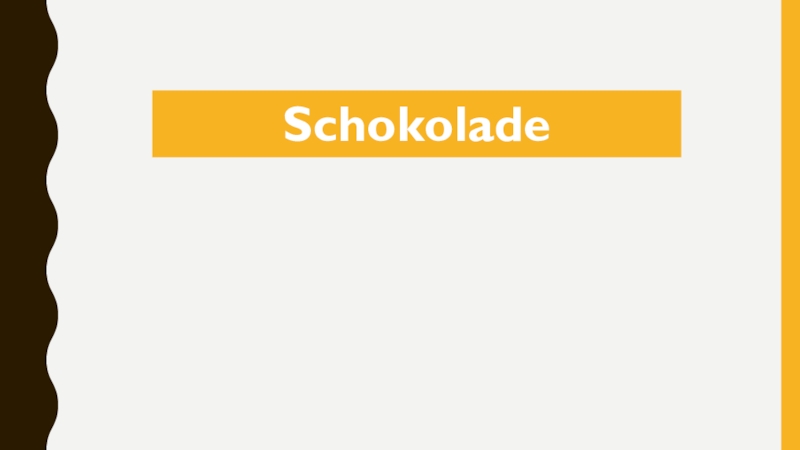- Главная
- Разное
- Образование
- Спорт
- Естествознание
- Природоведение
- Религиоведение
- Французский язык
- Черчение
- Английский язык
- Астрономия
- Алгебра
- Биология
- География
- Геометрия
- Детские презентации
- Информатика
- История
- Литература
- Математика
- Музыка
- МХК
- Немецкий язык
- ОБЖ
- Обществознание
- Окружающий мир
- Педагогика
- Русский язык
- Технология
- Физика
- Философия
- Химия
- Шаблоны, фоны, картинки для презентаций
- Экология
- Экономика
Презентация, доклад на тему Материал вебинара Формирование продуктивных компетенций (письмо)
Содержание
- 1. Материал вебинара Формирование продуктивных компетенций (письмо)
- 2. УМК «ВУНДЕРКИНДЫ ПЛЮС» ДЛЯ 5–11 КЛАССОВнемецкий язык
- 3. an association of language test providers who
- 4. COMMON EUROPEAN FRAMEWORK OF REFERENCE FOR LANGUAGES:
- 5. Table 1 – Macro-functional basis of CEFR
- 6. Production Production includes both speaking and writing activities.
- 7. Written ProductionIn the categories for written production,
- 8. WRITTEN PRODUCTION OVERALL WRITTEN PRODUCTION C2 Can
- 9. Creative writing involves personal, imaginative expression in
- 10. CREATIVE WRITINGC2Can write clear, smoothly flowing and
- 11. Письмо
- 12. Слайд 12
- 13. Слайд 13
- 14. Слайд 14
- 15. Слайд 15
- 16. Слайд 16
- 17. Слайд 17
- 18. Written reports and essays covers more formal
- 19. WRITTEN REPORTS AND ESSAYSC2Can produce clear, smoothly
- 20. Слайд 20
- 21. Слайд 21
- 22. Слайд 22
- 23. Production Strategies Communication strategies are presented in
- 24. PLANNING C2 No descriptors available; see C1C1
- 25. Compensating Compensating is a strategy for maintaining
- 26. COMPENSATING C2 Can substitute an equivalent term
- 27. Monitoring and repair Monitoring and repair covers
- 28. MONITORING AND REPAIR C2 Can backtrack and
- 29. languages@prosv.ru 8 (495) 789-30-40 доб.: 40-57, 41-48, 44-24, 45-17www.prosv.ruwww.inyaz.prosv.ru www.iyazyki.ruАО «Издательство «Просвещение» Центр лингвистического образования
Слайд 2УМК «ВУНДЕРКИНДЫ ПЛЮС» ДЛЯ 5–11 КЛАССОВ
немецкий язык как 1-ый иностранный;
линия УМК
3 часа в неделю и более;
УМК предназначен для общеобразовательных организаций и школ с углублённым изучением немецкого языка;
разворотный принцип подачи материала;
один разворот рассчитан на один 45-минутный урок(все развороты пронумерованы);
каждый УМК имеет свою сюжетную линию;
коммуникативная направленность;
подготовка к ОГЭ и ЕГЭ.
Слайд 3an association of language test providers who work together to promote
Слайд 4COMMON EUROPEAN FRAMEWORK OF REFERENCE FOR LANGUAGES: LEARNING, TEACHING, ASSESSMENT COMPANION
Language Policy Programme Education Policy Division Education Department Council of Europe
Russia
Globus International Language Centres National Research University Higher Schools of Economics,
Moscow Lomonosov State University Nizhny Novgorod Linguistics University
Samara State University
Moscow State Institute of International Relations
St Petersburg State University
Institutes (organized in alphabetical order by country) that participated between February and November 2015 in the validation of the descriptors for mediation, online interaction, reactions to literature and plurilingual/pluricultural competence, and/or assisted in initial piloting. The Council of Europe also wishes to thank the many individual participants, all of whose institutes could not be included.
Слайд 5Table 1 – Macro-functional basis of CEFR categories for communicative language
Слайд 6Production
Production includes both speaking and writing activities. Spoken production is a
Judgements are made of what has been submitted in writing or of the fluency and articulateness in speaking, especially when addressing an audience. Ability in this more formal production is not acquired naturally; it is a product of literacy learnt through education and experience. It involves learning the expectations and conventions of the genre concerned. Production strategies are employed to improve the quality of both informal and formal production. Planning is obviously more associated with formal genres, but Monitoring and Compensating for gaps in vocabulary or terminology are also a quasi-automated process in natural speech.
Слайд 7Written Production
In the categories for written production, the macro-functions ‘transactional language
Creative writing is the written equivalent of Sustained monologue: Describing experience, and focuses on description and narrative.
Слайд 8WRITTEN PRODUCTION
OVERALL WRITTEN PRODUCTION
C2
Can write clear, smoothly flowing, complex texts
C1
Can write clear, well-structured texts of complex subjects, underlining the relevant salient issues, expanding and supporting points of view at some length with subsidiary points, reasons and relevant examples, and rounding off with an appropriate conclusion.
Can employ the structure and conventions of a variety of written genres, varying the tone, style and register according to
addressee, text type and theme.
B2
Can write clear, detailed texts on a variety of subjects related to his/her field of interest, synthesising and evaluating
information and arguments from a number of sources.
B1
Can write straightforward connected texts on a range of familiar subjects within his/her field of interest, by linking a series of shorter discrete elements into a linear sequence.
A2
Can write a series of simple phrases and sentences linked with simple connectors like ‘and,’ ‘but’ and ‘because’.
A1
Can give information in writing about matters of personal relevance (e.g. likes and dislikes, family, pets) using simple words and basic expressions.
Can write simple isolated phrases and sentences.
Pre-A1
Can give basic personal information in writing (e.g. name, address, nationality), perhaps with the use of a dictionary.
Слайд 9Creative writing
involves personal, imaginative expression in a variety of text
► aspects described, from simple everyday information, through a variety of subjects related to fields of interest to engaging stories and descriptions of experience;
► types of texts: from diary entries and short, imaginary biographies and simple poems, to wellstructured and developed descriptions and imaginative texts;
► complexity of discourse: from simple words and phrases, through clear connected text, to following established conventions of the genre concerned in clear, well-structured, smoothly flowing text;
► use of language: from basic vocabulary and simple sentences, to an assured, personal, natural style appropriate to both the genre adopted and the reader.
Слайд 10CREATIVE WRITING
C2
Can write clear, smoothly flowing and engaging stories and descriptions
Can exploit idiom and humour appropriately to enhance the impact of the text.
C1
Can write clear, detailed, well-structured and developed descriptions and imaginative texts in an assured, personal, natural style appropriate to the reader in mind.
Can incorporate idiom and humour, though use of the latter is not always appropriate.
Can write a detailed critical review of cultural events (e.g. plays, films, concerts) or literary works.
Can write clear, detailed descriptions of real or imaginary events and experiences marking the relationship between ideas in clear connected text, and following established conventions of the genre concerned.
B2
Can write clear, detailed descriptions on a variety of subjects related to his/her field of interest.
Can write a review of a film, book or play.
Can clearly signal chronological sequence in narrative text.
Can write a simple review of a film, book or TV programme using a limited range of language.
B1
Can write straightforward, detailed descriptions on a range of familiar subjects within his/her field of interest.
Can write accounts of experiences, describing feelings and reactions in simple connected text.
Can write a description of an event, a recent trip – real or imagined.
Can narrate a story.
Can write about everyday aspects of his/her environment e.g. people, places, a job or study experience in linked sentences.
Can write very short, basic descriptions of events, past activities and personal experiences.
Can tell a simple story (e.g. about events on a holiday or about life in the distant future).
A2
Can write a series of simple phrases and sentences about their family, living conditions, educational background, present or most recent job.
Can write short, simple imaginary biographies and simple poems about people.
Can write diary entries that describe activities (e.g. daily routine, outings, sports, hobbies), people and places, using basic, concrete vocabulary and simple phrases and sentences with simple connectives like ‘and,’ ‘but’ and ‘because’.
Can write an introduction to a story or continue a story, provided he/she can consult a dictionary and references (e.g. tables of verb tenses in a course book).
A1
Can write simple phrases and sentences about themselves and imaginary people, where they live and what they do.
Can describe in very simple language what a room looks like.
Can use simple words and phrases to describe certain everyday objects (e.g. the colour of a car, whether it is big or small).
Pre-A1 No descriptors available
Слайд 18Written reports and essays
covers more formal types of transactional and
► content: from familiar subjects of interest and routine factual information, to complex academic and professional topics, distinguishing one’s own viewpoints from those in the sources;
► type of texts: from short reports and posters, to complex texts which present a case, or give critical appreciation of proposals or literary works;
► complexity of discourse: from linking sentences with simple connectors, to smoothly flowing expositions with effective logical structure.
Слайд 19WRITTEN REPORTS AND ESSAYS
C2
Can produce clear, smoothly flowing, complex reports, articles
of proposals or literary works.
Can provide an appropriate and effective logical structure which helps the reader to find significant points.
Can set out multiple perspectives on complex academic or professional topics, clearly distinguishing his/her own ideas and
opinions from those in the sources.
C1
Can write clear, well-structured expositions of complex subjects, underlining the relevant salient issues.
Can expand and support points of view at some length with subsidiary points, reasons and relevant examples.
Can write a suitable introduction and conclusion to a longer report, article or dissertation on a complex academic or
professional topic provided that the topic is within his/her field of interest and there are opportunities for redrafting and
revision.
Can write an essay or report that develops an argument systematically with appropriate highlighting of significant points
and relevant supporting detail.
Can write a detailed description of a complex process.
B2
Can evaluate different ideas or solutions to a problem.
Can write an essay or report which develops an argument, giving reasons in support of or against a particular point of view
and explaining the advantages and disadvantages of various options.
Can synthesise information and arguments from a number of sources.
Can write short, simple essays on topics of interest.
Can write a text on a topical subject of personal interest, using simple language to list advantages and disadvantages, give
and justify his/her opinion.
Can summarise, report and give his/her opinion about accumulated factual information on familiar routine and non-routine
matters within his/her field with some confidence.
B1
Can write very brief reports to a standard conventionalised format, which pass on routine factual information and state
reasons for actions.
Can present a topic in a short report or poster, using photographs and short blocks of text.
A2
Can write simple texts on familiar subjects of interest, linking sentences with connectors like ‘and,’ ‘because,’ or ‘then.’
Can give his/her impressions and opinions in writing about topics of personal interest (e.g. lifestyles and culture, stories),
using basic everyday vocabulary and expressions.
A1 No descriptors available
Pre-A1 No descriptors available
Слайд 23Production Strategies
Communication strategies are presented in the CEFR in relation to
Planning
Planning is concerned with mental preparation before speaking or writing. It can involve thinking consciously about what to say and how to formulate it; it can also involve rehearsal or the preparation of drafts. Key concepts operationalized in the scale include the following:
► working out how to express the point that needs to be got across, and perhaps rehearsing expression;
► considering how recipients may react to what is said.
Слайд 24PLANNING
C2
No descriptors available; see C1
C1
Can, when preparing a more
Can, in preparing for a potentially complicated or awkward situation, plan what to say in the event of different reactions, reflecting on what expression would be appropriate.
B2
Can plan what is to be said and the means to say it, considering the effect on the recipient(s).
Can rehearse and try out new combinations and expressions, inviting feedback.
B1
Can work out how to communicate the main point(s) he/she wants to get across, exploiting any resources available and limiting the message to what he/she can recall or find the means to express.
A2
Can recall and rehearse an appropriate set of phrases from his/her repertoire.
A1
No descriptors available
Pre-A1
No descriptors available
Слайд 25Compensating
Compensating is a strategy for maintaining communication when one cannot think
► paralinguistic gesture to support language;
► deliberately using a ‘wrong’ word and qualifying it;
► defining the missing concept;
► paraphrasing (circumlocution) and the extent to which such paraphrasing is evident.
Слайд 26COMPENSATING
C2
Can substitute an equivalent term for a word he/she can't
C1
Can exploit his/her range of vocabulary options creatively so as to readily and effectively use circumlocution in almost all situations.
Can use circumlocution and paraphrase to cover gaps in vocabulary and structure.
B2
Can address most communication problems by using circumlocutions, or by avoiding difficult expressions.
Can define the features of something concrete for which he/she can't remember the word.
Can convey meaning by qualifying a word meaning something similar (e.g. a truck for people = bus).
B1
Can use a simple word meaning something similar to the concept he/she wants to convey and invites ‘correction’.
Can foreignise a mother tongue word and ask for confirmation.
Can use an inadequate word from his/her repertoire and use gesture to clarify what he/she wants to say.
A2
Can identify what he/she means by pointing to it (e.g. ‘I'd like this, please’).
A1
Can use gesture to support simple words in expressing a need.
Pre-A1
Can point to something and ask what it is.
Слайд 27Monitoring and repair
Monitoring and repair covers both (a) the spontaneous realization
► changing tack and using a different tactic – very obviously at A levels, very smoothly at C levels;
► self-correcting slips, errors and ‘favourite mistakes;
► the extent to which a communication problem must be evident before repair is undertaken.
Слайд 28MONITORING AND REPAIR
C2
Can backtrack and restructure around a difficulty so
C1
Can backtrack when he/she encounters a difficulty and reformulate what he/she wants to say without fully interrupting the flow of speech.
Can self-correct with a high degree of effectiveness.
Can often retrospectively self-correct his/her occasional ‘slips’ or non-systematic errors and minor flaws in sentence structure.
B2
Can correct slips and errors if he/she becomes conscious of them or if they have led to misunderstandings.
Can make a note of ‘favourite mistakes’ and consciously monitor speech for it/them.
Can correct mix-ups with tenses or expressions which lead to misunderstandings provided the interlocutor indicates there is a problem.
B1
Can ask for confirmation that a form used is correct.
Can start again using a different tactic when communication breaks down.
A2 No descriptors available
A1 No descriptors available
Pre-A1 No descriptors available
